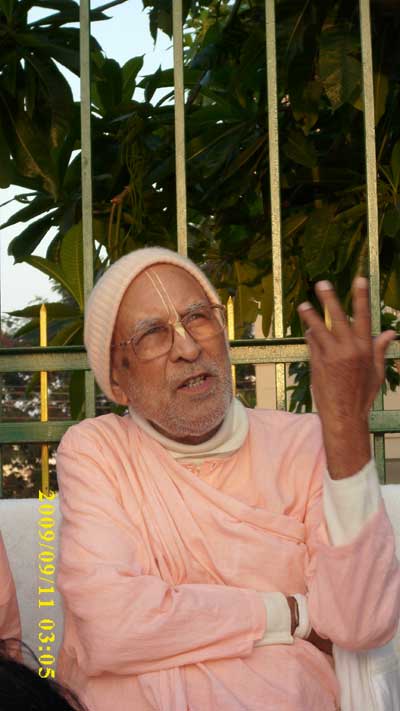
By the causeless mercy of Srila Gurudeva Sri Srimad Bhaktivedanta Narayana Gosvami Maharaja, the devotees in Bangalore, headed by Sripad B.V. Vaikhanas Maharaja, B.V. Dandi Maharaja, and B.V. Visnu-daivata Maharaja, celebrated their 6th annual Janmastami festival. This year a big pandal was erected next to our preaching center in HSR layout Bangalore.
Many devotees from Mathura-Vrndavana came to assist in the function. By their sweet bhajans and hari-katha they delighted the crowd and helped them enter into the real mood of Sri Krishna Janmastami. At midnight a grand abhisheka was performed for Sri Sri Radha-Vinodabihariji with Pancamrta and various other auspicious articles.
As the abhisheka was coming to a completion and the Deities were being bathed with the last kailash (pot) of water, a most wonderful occurrence took place. The heavens opened up and a great downpour of rain began. The rain lasted all night and it was the largest rain of the year, measuring up to almost a foot of water. Moreover, it only rained in the surrounding locality of our festival, a radius of five square km and nowhere else in Banglore. The local people were speaking about this extraordinary event for weeks on end, and were saying that this was a sign that Sri Krsna Himself was present at the festival. Even the media took note of this uncommon occurrence of rain in the midst of a season that was considered to be a drought.
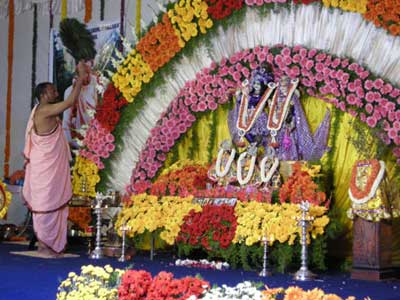
On Janmastami Day more than thirty-five hundred people came and took darsan of Sri Sri Radha-Vinodabihariji, listened to hari-katha and honored maha prasadam. Sri Nandotsava and the Appearance Day of Srila A.C. Bhaktivedanta Svami Prabhupada were celebrated on the next day, with a maha-prasadam feast of twenty-two preparations distributed to all the faithful participants.
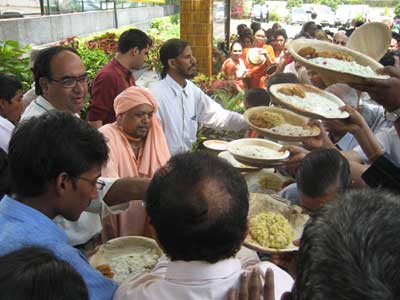
Three weeks later, shortly after Radhastami, Srila Gurudeva came to Bangalore for the third time to visit the devotees there. He stayed for seven days, from the 9th to 15th of September. More than thirty devotees came along with him from Mathura-Vrindavana and Mumbai.
Srila Gurudeva was welcomed with so much love and affection from the devotees in Bangalore. He was staying for several days in the apartment of Chandrakanta Prabhu and Sudevi dasi, which is above the temple. They made many nice arrangements for him. For example, they bought a huge, beautiful, wooden swinging chair for his pleasure. Their son and daughter pleased him very much by quoting some slokas that they had learned.
One evening before the programs, Gurudeva gave darsana in the temple and asked all the sannyasis to speak, after which he spoke and pointed out the importance of the state of Karnataka. He explained that Bhakti-devi appeared in Dravid (South India) and came to Karnataka before going to Maharastra. He also mentioned that during the time that Lord Ramacandra was in exile, when Ravana kidnapped Sita, He came there to Kiskinda searching for her. Also, Sri Caitanya Mahaprabhu came there on His south Indian tour, drowning everybody in prema through harinama sankirtana.
During Srila Gurudeva’s stay, three programs were organized. The first two days, the program was held at the National Institute of Fashion Technology near our temple on the outskirts of Bangalore. More than five hundred people attended the lecture each night.
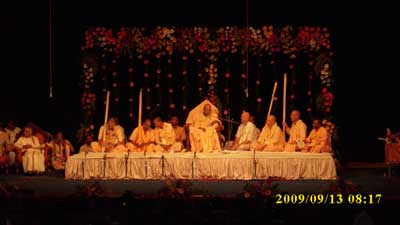
The first evening, Srila Gurudeva astounded the audience by explaining the deep meaning of uttama-bhakti as defined by Srila Rupa Gosvami, as well as the gradation of devotees and their teachings as explained by Srila Sanatana Goswami in his Sri Brhad Bhagavatamrta. He asked the devotees to speak on Prahlada Maharaja, who is a jnani-bhakta,;Ambarisa Maharaja, who is a suddha-bhakta; Hanuman, who is a premi-bhakta; the Pandavas, who are premapara-bhaktas; and Uddhava, who is a prematura-bhakta. Then he gave the conclusion that the gopis are above and beyond all these different levels of bhaktas, being completely selfless, offering their mind, body, senses, and words for the pleasure of Krsna.
The following evening he began to speak on the Tenth Canto of Srimad Bhagavatam, beginning with Krsna's birth pastimes, asking the different sannyasis to speak on the killing of Putana, Trinavarta, Sakatasura, Aghasura, Damodara-lila, the Fruitseller lila, and Brahma vimohana-lila.
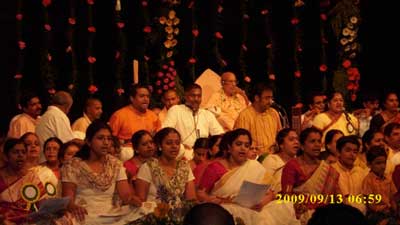
On the third day, at 11.00 AM, a big religious assembly (dharma-sabha) was held at the Chowdaiah Memorial Hall in the center of the city, and over one thousand people attended. Local dignitaries were invited such as the retired judge of the Supreme Court, Sri N. Venkatachala; and the Kannada Sahitya Parishat President, Prof. G. Venkata Subbaiah; and the local MLA, Dr. Aswatha Narayana. They all greatly honored Srila Gurudeva and also received much respect from him in return. A musical performance called “Sata Kantha Sangita Sankirtana” was performed by one hundred singers singing simultaneously in the same raga. The theme of the lecture was “The essence and beauty of sanatana-dharma.”
Srila Gurudeva stunned the audience by his deep insights and realizations into the true nature of sanatana-dharma. He said the general understanding of sanatana dharma is to perform our daily duties, dharma (religion), artha (economic development), kama (sense gratification), and finally attain moksa (liberation); but the true meaning of sanatana-dharma is something else. Sanatana-dharma means that which never takes birth nor will ever be destroyed, in other words, nitya (eternal) dharma or Bhagavat dharma. Our soul is sanatana (eternal). The relationship between two eternal objects, the individual soul and Paramatma, the Supreme Soul, is sanatana-dharma.
In general, people think that sanatana-dharma is just related to the body, serving one's parents, performing household duties and worshipping the demigods. However, following real sanatana-dharma or bhagavata-dharma gives immortality and leads one to Vaikuntha or even Goloka Vrndavana. Therefore Srimad Bhagavatam states:
aho bhagyam aho bhagyam
nanda-gopa-vrajaukasam
yan-mitram paramanandam
purnam brahma sanatanam
“How greatly fortunate are Nanda Maharaja, the cowherd men and all the other inhabitants of Vrajabhumi! There is no limit to their good fortune, because the Absolute Truth, the source of transcendental bliss, the eternal Supreme Brahman, has become their friend.”
Krsna is here addressed as purna-brahma (the complete Absolute Truth) and sanatana-brahma (the eternal Lord).
mamaivamso jiva-loke
jiva-bhutah sanatanah
manah-sasthanindriyani
prakrti-sthani karsati
“The living entities in this conditioned world are My eternal fragmental parts. Due to conditioned life, they are struggling very hard with the six senses, which include the mind.”
Krsna says to Arjuna “I am eternal, My parts and parcels, the jivas, are also eternal. The atma (soul) is present in all bodies. The moment the atma leaves the body, the body is useless.
acchedyo ’yam adahyo ’yam
akledyo ’sosya eva ca
nityaù sarva-gatah sthanur
acalo ’yam sanatanah
“This individual soul is unbreakable and insoluble and can be neither burned nor dried. He is everlasting, present everywhere, unchangeable, immovable and eternally the same.”
The relation between atma and Paramatma is sanatana-dharma.
sa vai pumsam paro dharmo
yato bhaktir adhoksaje
ahaituky apratihata
yayatma suprasidati
“The supreme occupation (dharma) for all humanity is that by which men can attain to loving devotional service unto the transcendent Lord. Such devotional service must be unmotivated and uninterrupted to completely satisfy the self.”
Uttama-bhakti or pure love for Krsna is defined by Srila Rupa Gosvami thus:
anyabhilasita-sunyam jnana-karmady-anavrtam
anukulyena krsnanu-silanam bhaktir uttama
“Uttama bhakti, pure devotional service, is the cultivation of activities that are meant exclusively for the benefit of Sri Krsna. It is the uninterrupted flow of service to Sri Krsna performed through all endeavors of the body, mind and speech, as well as through expressions of various spiritual sentiments (bhavas). It is not covered by jnana, speculative knowledge aimed at impersonal liberation, karma, reward seeking activity, and it is completely free from desires other than the aspiration to bring happiness to Sri Krsna.”
Without knowledge (jnana) we cannot exist. But there are two types of jnana:
1. The idea that God is impersonal (Brahma is nirvisesa, nirakara, niranjana jnana).
2. Knowledge of devotion to Krsna, knowledge of the eternal living-being, knowledge of maya, love of God, and the established truths of Srimati Radhika (bhakti-tattva-jnana, jiva-tattva, maya-tattva, prema-tattva, radha-tattva).
Bhakti does not become covered by bhakti-tattva-jnana, whereas bhakti does become covered by brahma-jnana. When we perform karma for Bhagavan, our bhakti does not become covered, but if we perform bhakti for ourselves, our bhakti does become covered.
Sanatana-dharma has manifested from different sastras.
Vedanta sutra states: “arupad eva hi tat-pradhanatvat – appearing as if not having a form.”
Krsna is not beautiful, He is beauty personified. Krsna has no form, He is form personified. The Vedas have accepted Krsna's qualities (guna), form (rupa) and pastimes (lila).
Bhagavan is Paramabrahma, the Supreme Truth. He is the creator of the universes. He is the origin of all creation and was there before the creation, and He will be there after the creation.
In the first Chapter of the Bible it is said, “God created man after His own image.” He created human beings according to His own form. If God does not have form, than how would He be able to create human beings from His own image? These days some Christians do not accept this. Should we just cut that line out of the bible? Even in the Koran, the same thing is stated: Allah, or Kuddha has form. Therefore it has been accepted that Kuddah or God has form. However, only sanatana-dharma has fully embraced the personal conception of God.
What is the meaning of God? Generator, Operator and Destroyer. If God is devoid of qualities, how could He have compassion for the jivas? And what would be the benefit of worshipping that Allah or Kuddha if He is without mercy, or stone-hearted? Krsna is causelessly merciful – He gives mercy without any discrimination. He came to give mercy in the form of Ramacandra, Nrsimhadeva and all other incarnations.
The jiva is the eternal servant of Krsna. The moment the jiva forgets this, the deluding potency maya captures him, gives him a body, and sends him far away from the Lord. Due to maya, the jiva has forgotten his real identity as an eternal soul and has accepted his body as his very self. This is the disease of mankind. People think, “I am educated,” “I am learned,” “I am a doctor,” “I am an engineer,” or “I am a lawyer,” but all these conceptions are temporary.
Bhakti-devi took birth in South India. Madhvacarya's place is Udupi in South India. Even today the Deity he established is worshiped there. Madhvacarya, Visnusvami, and Nimbaditya all appeared in South India and preached Krsna-bhakti there. They defeated Sankaracarya's philosophy that the jiva is actually brahma, declaring: sarva kalvidam brahma (everything is that impersonal God); tatvam-asi (I am also that impersonal God); and aham brahmasmi (I am the spirit whole).
ete camsa kalah-pumsah krsnas tu bhagavan svayam
All avataras beginning with Rama and Nrsimha are the parts, and parts of the parts of the Supreme Person; but Sri Krsna is the original (Svayam) Bhagavan.
Krsna's complexion is syama color, darkish. He has form, qualities, and pastimes. He performed birth pastimes, Yasoda maiya bound Him, the sakhas (cowherd boys) climbed on His shoulders, He fell at the gopis’ feet, He performed rasa-lila, and He performed pastimes in Dvaraka – this is sanatan dharma.
Srila Gurudeva quoted and explained this verse in conclusion:
aradhyo bhagavan vrajesa-tanayas tad-dhama vrndavanam ramya kacid upasana vraja-vadhu-vargena ya kalpita, srimad-bhagavatam pramanam amalam prema pum-artho mahan sri-caitanya mahaprabhor matam idam tatradarao na parah
“Bhagavan Vrajendra-nandana Sri Krsna is our only worshipable object. In the same way that He is worshipful, so is His transcendental abode, Sri Vrndavana Dhama. The mood in which the young brides of Vraja (the gopis, especially Srimati Radhika) worship Him is the highest perfectional form of love of God. Srimad Bhagavatam alone is the immaculate scriptural evidence of this. Krsna-prema is the supreme objective of life (the fifth and highest goal of human life – beyond mundane religiosity, economic development, sense gratification, and impersonal liberation). These are the teachings of Sri Caitanya Mahaprabhu (His gaura-vani). We hold this conclusion (siddhanta) in supreme regard and have no inclination or respect for any other conclusion or cheating opinions.”
Afterwards Sri N. Venkatachala gave a speech, wherein he cited the teachings of Sri Sankaracarya. After hearing his presentation Gurudeva politely corrected him by saying, “Even though our respected guest has spoken nicely, he has mentioned one thing that has ruined his entire presentation. Scriptures like the Srimad Bhagavatam and Bhagavad-gita state: “Mamaivamso jiva-loke jiva-bhutah sanatanah (B.G. 15.7),” and “acchedyo ’yam adahyo ’yam akledyo ’sosya eva ca nityah sarva-gatah sthanur acalo ’yam sanatanah (B.G. 2.24).” This means that the jiva is an eternal part and parcel of Sri Krsna. How is it then that the jiva can merge into the Brahman and loose his quality of being sanatana? If there is only one Brahman, then where is the question of two objects (jiva and Brahman) merging? Therefore it has been explained by all our previous acaryas, such as Sri Ramanujacarya, Sri Madhvacarya, Sri Nimbaditya Acarya, and Sri Visnusvami that the jivas’ eternal position is that of a servant to Sri Krsna.” After hearing this, the retired judge was grateful to have been corrected and said “I never knew this fact. I am glad this has come to my knowledge.”
After these three programs, Srila Gurudeva visited our Sri Ranganatha Gaudiya Matha, which is in a beautiful area called Heseragatta on the outskirts of Bangalore. Sripada Dandi Maharaja has established a gurukula there, with about thirty young gurukula boys, who have become very devoted and learned under his expert guidance. Srila Gurudeva encouraged all the devotees to co-operate and preach the message of Sri Caitanya Mahaprabhu so that a temple can be quickly established for the benefit of the people in Bangalore. Gurudeva gave initiation to many devotees including some of the gurukula boys there. In fact, he mercifully gave initiation to more than one hundred and fifty devotees during his entire stay in Bangalore.
The next day Srila Gurudeva left for Jagannatha Puri.
Srila Gurudeva ki jaya!
Gaura Premanandi Hari Hari Bol!
Report submitted by: Giridhari dasa brahmacari, Bakula dasi and Caru Candrika dasi





